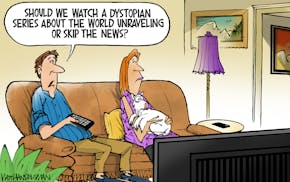Opinion editor's note: Star Tribune Opinion publishes a mix of national and local commentaries online and in print each day. To contribute, click here.
•••
With the advent of the movie "Oppenheimer," many comments have been offered about the man, the Manhattan Project and the ethics, options and aftereffects of the nuclear bombs dropped on Hiroshima and Nagasaki. Most comments have centered on the ethics of producing and utilizing a nuclear weapon. The debate is usually limited to whether or not it was appropriate to use such a weapon, but the argument seldom mentions the strategy the U.S. would most likely have used had we not dropped the bombs. We consider the damage caused by the atomic bombs to have been devastating. So is it possible that the alternative strategy could have been even worse?
This issue is personal for me since my father was headed to Japan on a Navy ship, and had he been forced to fight on Japanese soil there is a good chance that I, and many other baby boomers, wouldn't be here. But there is also a good chance that had this other option been used, Japan would have been significantly weakened to the point where a U.S. invasion of the island would have almost certainly guaranteed victory.
I first learned of this alternate strategy when I read James Bradley's 2003 book "Flyboys: A True Story of Courage." I learned that the U.S. Army Air Forces used incendiary bombs on strategic targets. These incendiary bombs consisted of jellied gasoline, which came to be known as napalm. Before reading this I had believed that napalm was a Vietnam-era product of Dow Chemical, which produced the controversial firebomb for the U.S. forces fighting there. Who hasn't seen the iconic, heart-wrenching photo of the naked young girl on the dirt road in Vietnam with parts of her body burned black? Napalm was in fact invented by chemist Louis Fieser at Harvard University in 1942.
The idea of aerial firebombing was first conceived by the Nazis' Luftwaffe in 1937 when they destroyed the Spanish city of Guernica during the Spanish Civil War. Picasso depicted this atrocity in one of his most famous paintings. The art of firebombing became perfected by the English and the Americans when they added incendiary bombs into the mix when bombing the German cities of Hamburg and Dresden.
In his book "Dresden," author Fredrick Taylor describes in great detail the manifold circumstances that needed to be synchronized for this type of bombing to create the desired effect, which was a firestorm that would reduce an entire city to ashes. The number of bombers and tonnage of bombs delivered, cloud cover, direction of attack, wind direction and intensity, target and delivery, etc. — all these factors had to be aligned for the perfect firestorm to occur, but if it did occur as it did in Dresden, the result was a fiery tornado that burned everything in its path and sucked the oxygen out the air so that even if you were protected from the fire you would suffocate.
American Gen. Curtis LeMay had a very basic strategy for winning the war: Kill as many of the enemy as possible until the enemy can no longer fight back. LeMay lacked social graces but is considered by many to have been one of the greatest combat commanders of all time. Creating the Strategic Air Command, he planned the firebombings of Japan that wiped out, among other cities, about 60% of Tokyo and killed more than 100,000 civilians. The firebombing of Japan's industrial areas was so successful that the Army ordered the tripling of napalm production in 1943. When the effects of this type of bombing were realized, they became LeMay's go-to armament.
There are wide discrepancies in estimates of Japanese civilians killed as a result of the firebombings, but the number is somewhere between 350,000 and 900,000.
Debates over the propriety of nuclear weapon leave out the fact that had we chose not to use the atomic bombs, LeMay would have continued to firebomb Japan to ashes. The number of dead civilians, already staggering, would have been multiplied dramatically. LeMay would have continued these devastating raids until we chose to invade or until Japan surrendered.
Ironically, the death toll from the atomic bombs was far fewer than those caused by firebombings. As far as the ethics of using nuclear weapons vs. jellied gasoline bombs, they were both terribly cruelly effective war tools. The lingering radiation caused by the atomic bombs make them even more devastating, but the survivors of Dresden and Tokyo might argue that.
Richard Greelis lives in Bloomington.

BWCA's future likely hinges on election
Saving the dinosaurs: Why there's a future for community newspapers
Readers Write: Gun storage laws, Uber and Lyft, 24/7 businesses, the pipe organ


